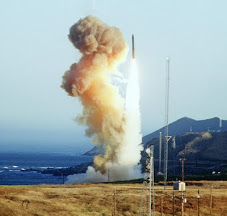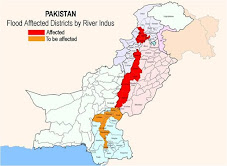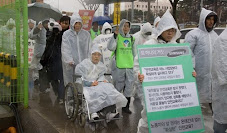No. 722
Military unveils plan to foster reserve snipers
Feb. 25, 2011 (Uploaded on March 4, 2011)
The Ministry of National Defense unveiled its revised training program for this year on Feb. 24 aimed at fostering combat-oriented reserve forces.
In particular, the ministry is planning to create some 30,000 reserve snipers.
"During past few years, the military has been running a program to develop reserve snipers in some reserve forces unit," said a defense official in the ministry. "But we decided to operate the plan in all reserve forces units in the country to make preparations for North Korea's special operations capabilities reinforcement and future street battles."
The official added that the military is going to foster two reserve snipers in each platoon.
Would-be snipers will receive training concentrating on rifle shooting and have telescope sight installed on their rifles if budget is secured, said the official.
In addition, this year's first reserve forces training program scheduled for Mar. 2 will be run in combat-oriented style.
So far reservists in their fifth and sixth year of reserve training since their discharge from active-duty service have taken training programs for three days by commuting from home to assigned units. As a test case, however, five army divisions will be running overnight training program.
In line with a new reserve force training plan, two reserve battalions will join in the ROK-U.S. annual joint military exercises Key Resolve/Foal Eagle and the Ulchi Freedom Guardian, according to the new plan.
Also local reserves training is going to be operated aimed at strengthening actual warfare capabilities to support the new plan. Trainees will be trained using tools for survival games and get training programs in many different fields.
The new reserve training plan said that in order to strengthen morale training, military or security experts will give one-hour lectures related to improving awareness of security enemies.
______________________________
No. 721
Ministry introduce major policies after three years of Lee
Feb. 23, 2011 (Uploaded on March 4, 2011)
Feb. 23, 2011 (Uploaded on March 4, 2011)
Ahead of marking the third year of Lee Myung-bak administration on March 25, the ministry made public its major achievements and tasks by dividing into five categories.

President Lee Myung-bak inspects the 21st Division of the Army on Dec. 23 last year. The Defense Ministry vowed to reform itself by becoming advanced military and the military that gain trust from the public.
Those categories are as follows: assessing current military combat capabilities and strengthening preparedness posture, thorough mental armament and boosting fighting spirit, improving efficiency of policy management, establishing advanced military competence and reinforcing ROK-U.S. strategic alliance and military diplomacy.
As part of reinforcing joint military operation of Army, Navy and Air Force, the ministry of National Defense is scheduled to finalize a plan aimed at running joint training programs for freshmen of the Military, Naval and Air Force academies by November this year.
The ministry is also planning to fortify west coast islands by 2015 to protect soldiers and residents on islands.
A new school for developing joint commanding skills for officers will be established on Jan. 1 next year as well, the ministry said.
As an initial step to strengthen preparedness posture on west coast islands, the ministry is planning to fortify major military facilities by 2012. By 2015 all facilities will be fortified.
In order to prepare for changed aspects of enemy's threat, specific combat operations are going to be revised with the Marine Corps headquarters in the lead.
To prepare for possible North Korea's third nuclear test and missile test, the ministry is going to operate joint crisis management system and create countermeasures in cooperation with the United States.
In particular, the ministry will set up safety zones in case of emergencies in order to minimize damages of people and secure operation efficiency.
Also the ministry is planning to beef up military welfare system, ease regulations of military facilities protective zones, reshuffle military organizational structure, reinforce stand-by military power and strengthen ROK-U.S. alliance.
__________________________________
No. 720
Joint maritime maneuver successfully accomplishedt maritime maneuver successfully accomplished
Feb. 22, 2011 (Uploaded on March 4, 2011)
The First Fleet of Korean Navy led the three-day joint maritime maneuver along with Army, Air Force and coast guard to a success and took advantage of the occasion to strengthen joint operational capabilities. The exercise began on Feb. 18.

A 1,800-ton frigate Busan under the First Fleet of Korean Navy fires cannon toward simulated target during a joint maritime maneuver of Navy, Army, Air Force and coast guard.
During the maneuver, which took place on the East Sea, the fleet mobilized 12 battle ships, including a 1,800-ton frigate Busan and a 1,200-ton Patrol Combat Corvette, as well as a P-3C anti-submarine and surveillance aircraft and a Lynx helicopter.
Army soldiers of 23rd Division, Air Force aircrafts and two coast guards ships join the exercise to boost joint combat capabilities.
The exercise began with battleships making shipment and aircrafts taking off during a simulated situation of enemy's fighter flying toward Korea's harbor. Then drills aimed at securing the harbor, firing potential enemy submarines and fighters, and countering enemy's intrusion from the Northern Maritime Line (NLL), a de facto maritime border.
Joint forces, in particular, heightened the level of drill related to regional warfare near the NLL. Navy's speed boat played a role of enemy's boat and simulated as it sailed toward the South by crossing the NLL. Navy's patrol ship and a speed boat near the NLL sailed toward the enemy right away. With a support of Army's coastal artilleries and Air Force's attack, simulated enemy's speed boat was completely contained and attacked.
In addition, joint forces implemented an exercise of tracking and destroying enemy submarines as well as night drill to reinforce combat capabilities. In particular, on the second day of the maneuver, actual ruined fishing boat played a role of target during anti-submarine firing drill.
"No matter what enemy's provocation might be, our navy is fully prepared to counteract immediately," said Lt. Lim Sang-su who was in charge of operational control in the maneuver. "We will keep on maintaining perfect counteract capabilities based on actual maritime exercises."

![[URGENT PLEA: In Update] EMERGENCY in GANGJEONG Since AUG. 24, 2011](https://blogger.googleusercontent.com/img/b/R29vZ2xl/AVvXsEiQvpaNf6EePZVucu97_JphYsFS5IgumnSiA4YAmen1PZcim6vMmW7XjZ7J6nLh-Cu36mwBN5n1evrA3ey0vYMpwlAGsgnSFggv6a1w4Qx9BvvqOB0hy0BIcBkL2Exfs3zIxBsBuDGa1kzg/s227/jejusit.jpg)



![[Solidarity from Japan for the Jeju] 253 individuals and 16 groups/organizations](https://blogger.googleusercontent.com/img/b/R29vZ2xl/AVvXsEivji7100kBkr0hzvqYfh4IBBilkZ6XgDIg89jOxS6kTssxsVKC6Wm-fZbKOEsiy3zcO-9gW6GHspD5R_2C9WsGx5S1Z5VPj_OVRF7H6dxdaT0S-2H1eqsDsYvIwOV26VscxTHnKmP5iZmh/s227/jeju_12_10j.jpg)

![[Translation] Korean organizations' statement: Immediately cancel the joint ROK-US drill Nov 26](https://blogger.googleusercontent.com/img/b/R29vZ2xl/AVvXsEgfKDMo-qyEjm5asUtHlREyJY_5Ou-2tyB8SH6aUxiViRbbKR-8W_rirFiGp5DYSoD_KaeNOPMWR0af0ZPUIbJKmR89ImDvADHsGAIqsJVBvJNBEIl5wLd3G_zhPDW3Z2SxsHXadOsXe8st/s227/1.jpg)
![HOT! [Hankyoreh Hani TV] Beneath the Surface: the investigation into the sinking of the Cheonan](https://blogger.googleusercontent.com/img/b/R29vZ2xl/AVvXsEh80rL3Qv9GnfHSqbYMfivdqX5gZN-1O_VQj3A_Gk3yjWdybHwJCsprA3l6cEQB0cYCP2oNeaLo2ohLGIy0Uqqkv_fRkBevGJ2f-qkKD5eP1ZGsKeQ-r-jHUUb79WvucIN7hpEtXza4xXCL/s227/HaniTV+Cheonan.gif)



![[Translation]Statement against illegal inspection and unjust lay-off by the Kunsan USAFK!(Nov_2010)](https://blogger.googleusercontent.com/img/b/R29vZ2xl/AVvXsEg3JlQ-lreusCIJo5Yv2e3ZrRwrSMUE7UQxlrDVjmBehl0Pa24QZIAbZ5vUpgnnExbkKL9PdCwxVYSHWJkr_XK0FM4EhU3CMFhqfborVNu_p4v3bEFpNm3ia-aEHnvMMuEBI27aB7_BETuJ/s227/gunsan+protest.gif)
![[Translation] Korean organizations' statement against dispatching special force to the UAE on Nov.](https://blogger.googleusercontent.com/img/b/R29vZ2xl/AVvXsEiU7TNhTDLLwZkKP0Z78JsCZKp6je-QSFll3_ThmLES_y_nPLXEzeakrsZXoNxhN5blopEhy6xGV2tneJrniPdTR-JvOQMmSLr_HhlucxFvbusxk4oKvvMO2laBOHSIkB9OOeOxrQlqCA0O/s227/antiwarpeace.jpg)
![[Translation] Stop, Joining MD!: South Korean activists' statement and writing on Oct. 25, 2010](https://blogger.googleusercontent.com/img/b/R29vZ2xl/AVvXsEggGIHVei8j7LCJPJB5HIrspd942q436daNTquP-pFd45Cl70Ml_1JFiFDHgKu6FcoqNgFVKIFqjeuSPau2k_BwGHhx0cqFFL2-4ybZSTlmua0_AsERBtKYQa7jZk7uNj41LX6rj2vksHbo/s227/StopMD.jpg)
![[In Update] People First, NO G-20 (Nov. 6 to 12, Korea)](https://blogger.googleusercontent.com/img/b/R29vZ2xl/AVvXsEhZl8VTqeL7o2ndliGIE-sZFCikbTgfB9KCc3AtZvDaYijBBEhdfultMEOpyrCaD5gzpH8mqfWjU20KXMbSUl-5KM7yQeHU6z3BWV8tiOy4UKaCudz9VKWoi5x58xdC_gQpJTjkR5u7O9xf/s227/left21_G20.jpg)
![[International Petition] Stop US helipad plan in Okinawa to save great nature](https://blogger.googleusercontent.com/img/b/R29vZ2xl/AVvXsEihgYmdb0N8ViPvTFC_5i-Psbt4eX_LnAUEOtZkUngv_pGvRyWag1r6W60NicLLyTgWq-sPT1hBxLY5SadEIVv5McfZQ5uIhe-W0VoflQNqojsYZjFW6AH-gB1jsmSDGnGuKIFk2UkvNbFG/s227/yanbaru_w.jpg)

![[Global Network] against the first launch of Quasi-Zenith Satellite, Japan, on Sept. 11, 2010](https://blogger.googleusercontent.com/img/b/R29vZ2xl/AVvXsEj2sYpfodDDMIA7qXwuda0DmKapxXFB479fDnn8RKy7QNZqz0VEvWucNd-DleZ37hWNXC-Z8QtaqtM37VuPwac5SgclJ9_khBBSWOedvm19MRXIP1j1kcWrK6EW5IFjQdEEY2h7E6xuyNvC/s227/Qzss-45-0_09.jpg)

![[In update] Some collections on the Koreans’ protests against the sanction & war on Iran](http://4.bp.blogspot.com/_gnM5QlRx-4c/TJMvke6t8zI/AAAAAAAAFO4/tamQ8LUnOOA/S227/No+Sanction+on+Iran.jpg)
![[Three International Petitions] to End the Korean war and peace treaty(or peace resolution)](https://blogger.googleusercontent.com/img/b/R29vZ2xl/AVvXsEhlohLVYtpCg7iMsZhNYY4hBbhTi2dIheHMHWLDph9X2y78cjgZV1LeSfUJeu80elhJm70Q9E059q72lK-spSPvsRG4bPuCDIytltJB9IH3mWt9OG98HqhnTsPakwhvNeoCFUgF1xoxQ2EZ/s227/border.jpg)



![[Collection of Documents] No Base Learning and Solidarity Program_Korea(June 14 to 20, 2010)](https://blogger.googleusercontent.com/img/b/R29vZ2xl/AVvXsEix_HzjToh3nNGHBc-_5gasq-ykcaZ6GInLixILmZVyRJ5xoeHCxWOyYd9fSM7bmnuFsjSrYOGEPnQOwB1Dcyo-sN4Pw0cFPhUtKig_qlVnGL1Wi82ClvPqbEPWYhJiqdNF0DyzLIBETMB9/s227/No-Base-banner.jpg)
![Site Fwd:[John Hines] A U.S. Debate coach’s research trip on the Issues of Korea](https://blogger.googleusercontent.com/img/b/R29vZ2xl/AVvXsEg8yRra0zNhKHN74Auqhd3Nx9tZ7BWCGflRJHGH4CfzBT_yjhZ8Nl9b3OZuLpYWJ2exsjmR0oVl-Qq_cf832p2VdmOZhUi-lCFzCNeDSyVtweX1lWZPC-RlHmDMLtilHwHjNFTenBiM4Fk4/s227/Jeju-Peace-Tour.jpg)


![[News Update] Struggle Against the Jeju Naval Base since Jan. 18, 2010](https://blogger.googleusercontent.com/img/b/R29vZ2xl/AVvXsEhKfSTRC5QKBBSFIq_m7QIqXdlbL4-gF5GJYn9Q-pN__k7sV7uxGDcLY5L8xmU7QuWuUhBT_GhG-URBPO80RT3AfWfDrWJr06h1hFuZC6ZBVKe4U6PS1Cd7Kr6olO8TYQtk13Drox7IS6ea/s226/scrum1.jpg)


![[Urgent] Please spread the Letter!: There was no Explosion! There was no Torpedo! (May 26, 2010)](https://blogger.googleusercontent.com/img/b/R29vZ2xl/AVvXsEhSd2yWZ3xGwnJQXB73z5FgXCqSosAoB9_33-GLYprOmLqjmvgSAQp1BYI7e4slK1FDxHRi9KK4um-OpDaj8QOkXwAScVAgvvq6-ehbDA-hbkr96wT9oHNNmWnBPv8GU4hoZp9X8F9AZBX4/s227/grounded.jpg)
![Text Fwd: [Stephen Gowans]The sinking of the Cheonan: Another Gulf of Tonkin incident](https://blogger.googleusercontent.com/img/b/R29vZ2xl/AVvXsEi_L6hB3RZ1MovTXHe0A8yn_RfgMALGR0kM6poBuGp809xwvHtB_-PGWtS_WpyPWatyd9lB2pPqL2gOLc4dTCEdJ9sMvxJWEdapl-mMLm7WHAsV-jVpgqarVh8XBtdz_0c-Vohdh3HtJahD/s227/lee-myung-bak.jpg)
![[Japan Focus]Politics in Command: The "International" Investigation into the Sinking of the Cheonan](https://blogger.googleusercontent.com/img/b/R29vZ2xl/AVvXsEiHmTo8v-uCJnabRhMdnBAkC9J3s5bb2JsDKiT5leJHwbK8IDJHxfJmqQ_C0Is_bPC6UGMf05CA0exF2y4r2x9RhFUHT0kjsKviaME_MZXKnq775UyYAdb7w2SAzE75XvBfHp1al2q6i3cf/s227/wen_jiabao_and_lee_myungbak.png)
![[Japan Focus] Who Sank the SK Warship Cheonan? A New Stage in the US-Korean War and US-China](https://blogger.googleusercontent.com/img/b/R29vZ2xl/AVvXsEiKSS5ULT5QBaMGYpXXqBMX9jtwLwMLuK469b6Ku72GTJYKUObzTANaPjZqvvpPzYMJgPF53sjhvhK3DVa88ipYlggsJageykXlkxY6s8TW05xcU-_vfhf-pACUoaWuFbT-fsU1qEhm_yIi/s227/buoy_map.gif)
![[Updated on 12/13/10] [Translation Project] Overseas Proofs on the Damages by the Military Bases](https://blogger.googleusercontent.com/img/b/R29vZ2xl/AVvXsEikADE6JovUNspQyZUWVMTLAQg7yQNqXpVUbqZPk8f4uc_1723_xm1Cco6WAmstQXVPnaJAcb1mZA8Ny_3xONT_f5uh8MNLPnUhtqdGgy3HCtC1Vbbz4Q0ZY1Cssu-4cJEVNdrvznbS5UzO/s227/missile.jpg)
![[International Petition] Close the Bases in Okinawa](https://blogger.googleusercontent.com/img/b/R29vZ2xl/AVvXsEhNpQiHklwFbWVlFK7GDFXnBSOOSFEj3Il-We-N3uTDldKiidL2NGZs7X_LtTnatzTo_r8CexRkFe8NhfxYqmgp1knEEslROTfNjI5_mSb57cdbhPkftvanveYBaevAD9xuKDGoIxiTwoSb/s227/2.jpg)

![[In Update]Blog Collection: No Korean Troops in Afghanistan](https://blogger.googleusercontent.com/img/b/R29vZ2xl/AVvXsEjjEmCRXSNAG7_QBxKWbdksmxoWR4nyAovQTTdR1G2AuXh0jxtqNkI9OmYgYWRoLAJShvtBvE840QXuBWSVh3u3zMYqkNAFX6OWy3m5Nur4HM7uNK-pKT1ycyApJp-VLyhIFRRcoisYAh0E/s226/No-Troops-to--Afghanistan.jpg)











No comments:
Post a Comment